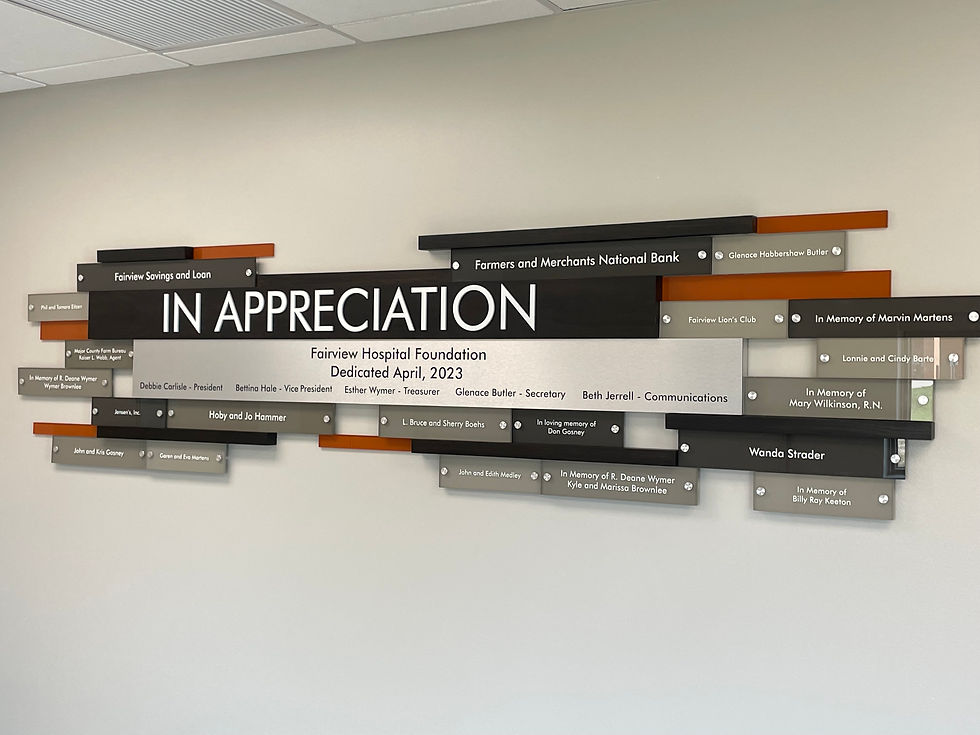9 Steps to Capital Campaign Success: The Power of Donor Recognition
- Steve Stobbe
- 17 hours ago
- 4 min read
A successful capital campaign is more than a fundraising effort—it’s a transformational moment for an organization. Whether you're building a new facility, expanding programs, or strengthening long-term sustainability, capital campaigns inspire donors to invest in a shared vision for the future.
But amid feasibility studies, leadership recruitment, cultivation strategies, and campaign marketing, one factor consistently shapes campaign outcomes: donor recognition.
Donor recognition is not simply a plaque on a wall. It is a communication strategy, a stewardship method, and a relationship-building practice that influences giving at every stage. For many donors—especially major and leadership-level contributors—recognition is a meaningful expression of gratitude and alignment with personal values.
Below are the 9 essential steps to capital campaign success, each elevated through intentional and creative donor recognition strategies that strengthen engagement and inspire long-term support.

1. Conduct a Feasibility Study
Before launching your capital campaign, a feasibility study helps determine:
How much you can realistically raise
Which donors may provide lead gifts
How the community perceives your project
What messaging resonates most
This stage offers early insight into how donors want to be acknowledged. Many feasibility interviews surface ideas such as naming opportunities, digital campaigns, donor walls, or exclusive events.
Recognition Tip: Use feasibility conversations to understand donor expectations—this shapes your recognition plan before it becomes a campaign deliverable.
2. Build a Strong Campaign Leadership Team
Your campaign committee—comprised of board members, community leaders, and key donors—carries your vision outward. Their enthusiasm and networks are invaluable.
Recognition Tip: Publicly honor campaign leaders early and often. Whether through printed materials, leadership listings, or special branded gifts, recognizing their role builds pride and momentum.
3. Define a Compelling Case for Support
The case for support answers every donor’s biggest question:“Why should I give?”
Your story must connect your campaign's goals to community impact. Donor recognition should also be part of that narrative—sharing how gifts will be honored demonstrates transparency and respect.
Recognition Tip: Include a section on naming opportunities and acknowledgment plans within your case messaging. This helps donors understand how their generosity will be celebrated.
4. Identify and Cultivate Major Donors
Major gifts are the backbone of capital campaigns, often contributing 60–80% of total fundraising. Cultivation efforts—meetings, tours, presentations—build relationships that set the stage for transformational gifts.
Recognition Tip: Personalize recognition. Some donors value public celebration; others prefer quiet acknowledgment. A flexible recognition plan ensures major donors feel honored in ways meaningful to them.
5. Create a Strategic Donor Recognition Plan
This is the heart of campaign stewardship.
A thoughtful donor recognition plan should include:
Naming opportunities for rooms, buildings, or programs
Donor walls or installations that visually tell your story
Digital donor recognition on websites, virtual tours, or screens
Printed listings in annual reports, event programs, or campaign booklets
Special events that celebrate key milestones
Ongoing recognition for multi-year pledges
Recognition is not just about aesthetics—it’s about reinforcing donor identity and showcasing your organization's gratitude.
Pro Tip: Stobbe Design specializes in donor recognition systems that honor donors beautifully while integrating seamlessly with architectural environments.
6. Launch the Quiet Phase
Most capital campaigns start quietly, securing major contributions before going public. This phase typically raises 60–70% of the goal.
Recognition plays a strategic role here:
Offering early naming opportunities
Showing confidential conceptual designs for recognition displays
Using recognition as an incentive for leadership-level giving
Recognition Tip: Provide visual mockups of donor walls, plaques, or signage. Tangible images help donors see the legacy their gift will create.
7. Go Public With the Campaign
Once you’ve secured significant lead gifts, your campaign enters the public phase. This is when you broaden your outreach to the community and rally support through events, media, and social platforms.
Recognition Tip: Feature early donors in public announcements, groundbreakings, or kickoff events. Public gratitude encourages others to join in and reinforces campaign momentum.
8. Celebrate Success With Donor Recognition Events
When the campaign reaches its goal—or hits major milestones—celebrate with your donors! Events reinforce community, honor generosity, and build long-term relationships.
These may include:
Ribbon cuttings
Hard-hat tours
Recognition ceremonies
Grand openings
Recognition Tip: Reveal donor installations or naming signage during celebration events for maximum emotional impact.
9. Maintain Long-Term Stewardship
Capital campaigns may end, but stewardship should continue. Donor relationships cultivated through the campaign support future fundraising efforts and foster lasting loyalty.
Ongoing stewardship may include:
Annual updates on the impact of the project
Invitations to special programs and events
Additional naming opportunities as your organization grows
Periodic recognition installation refreshes
Recognition Tip: Keep donor recognition dynamic. Digital displays or modular systems allow for easy updates and future expansion.
The Lasting Impact of Donor Recognition in Capital Campaigns
Donor recognition is not an afterthought—it's a foundational element of a successful capital campaign. When donors feel appreciated, valued, and seen, they are more likely to give generously, advocate for your mission, and stay engaged long-term.
At Stobbe Design, we help organizations bring their gratitude to life through expertly designed donor walls, signage systems, naming plaques, and recognition installations that tell powerful stories.
A well-executed capital campaign builds a building or program.
A well-executed recognition strategy builds community.




Comments